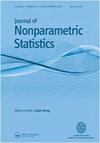具有信息间隔截短失效时间数据的线性变换模型的估计
IF 0.9
4区 数学
Q3 STATISTICS & PROBABILITY
引用次数: 1
摘要
线性变换模型是一种常用的失效时间数据回归分析模型,部分原因是它的灵活性。最近,它们被推广到可能存在治愈的子群体或审查可能具有信息的情况。在本文中,我们考虑了一种更为复杂和一般的情况,即既存在固定子群又存在信息审查,或者更具体地说,存在信息区间审查。正如文献中所指出的那样,没有考虑到治愈亚群或信息审查的分析可能会产生有偏见的估计或误导性的结论。针对这一问题,我们提出了一个三组分混合模型,并利用b样条曲线对未知函数进行了两步估计。所提出的方法非常灵活,易于实现。此外,所提出的回归参数的估计量是一致的和渐近正态的。进行了大量的仿真研究,结果表明该方法在实际情况下效果良好。此外,还提供了一个实际应用来说明所提出的方法。本文章由计算机程序翻译,如有差异,请以英文原文为准。
Estimation of linear transformation cure models with informatively interval-censored failure time data
Linear transformation models have been one type of models commonly used for regression analysis of failure time data partly due to their flexibility. More recently they have been generalised to the case where there may exist a cured subgroup or the censoring may be informative. In this paper, we consider a more complicated and general situation where both a cured subgroup and informative censoring, or more specifically informative interval censoring, exist. As pointed out in the literature, the analysis that fails to take into account either the cured subgroup or the informative censoring can yield biased estimation or misleading conclusions. For the problem, a three-component mixture cure model is presented and we develop a two-step estimation procedure with the use of B-splines to approximate unknown functions. The proposed approach is quite flexible and can be easily implemented. Also the proposed estimators of regression parameters are shown to be consistent and asymptotically normal. An extensive simulation study is conducted and suggests that the method works well for practical situations. Furthermore a real application is provided to illustrate the proposed methodology.
求助全文
通过发布文献求助,成功后即可免费获取论文全文。
去求助
来源期刊

Journal of Nonparametric Statistics
数学-统计学与概率论
CiteScore
1.50
自引率
8.30%
发文量
42
审稿时长
6-12 weeks
期刊介绍:
Journal of Nonparametric Statistics provides a medium for the publication of research and survey work in nonparametric statistics and related areas. The scope includes, but is not limited to the following topics:
Nonparametric modeling,
Nonparametric function estimation,
Rank and other robust and distribution-free procedures,
Resampling methods,
Lack-of-fit testing,
Multivariate analysis,
Inference with high-dimensional data,
Dimension reduction and variable selection,
Methods for errors in variables, missing, censored, and other incomplete data structures,
Inference of stochastic processes,
Sample surveys,
Time series analysis,
Longitudinal and functional data analysis,
Nonparametric Bayes methods and decision procedures,
Semiparametric models and procedures,
Statistical methods for imaging and tomography,
Statistical inverse problems,
Financial statistics and econometrics,
Bioinformatics and comparative genomics,
Statistical algorithms and machine learning.
Both the theory and applications of nonparametric statistics are covered in the journal. Research applying nonparametric methods to medicine, engineering, technology, science and humanities is welcomed, provided the novelty and quality level are of the highest order.
Authors are encouraged to submit supplementary technical arguments, computer code, data analysed in the paper or any additional information for online publication along with the published paper.
 求助内容:
求助内容: 应助结果提醒方式:
应助结果提醒方式:


